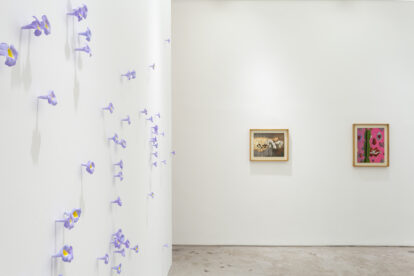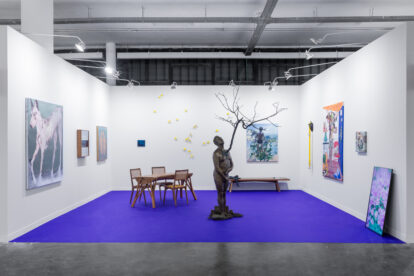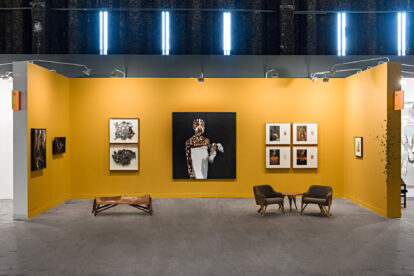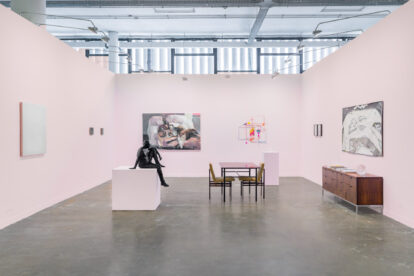There is a legend told by the Romans about two virtuous painters who started a dispute to define who would be the most skillful. Zeuxis unveiled a painting so realistic that birds approached trying to eat the grapes, and he boasted that he had tricked the animals. Parrhasius, for his part, asked his rival to lower the curtain that hid his work. Zeuxis, when trying to move the fabric away, realized that in fact the curtain was painted, having been deceived himself.
When entering Mauro Piva’s studio for the first time, it was possible to come across a series of scraps of paper fixed with masking tape on large blank sheets. In the torn fragments, disorganized colored spots of different tones and sizes could be seen – small rectangles of solid hue, large watery blots, lines of different textures and thicknesses. There were over thirty sheets on the wall. At first glance, an obvious conclusion: the artist had kept, and now organized, the color tests of different intensities, proportions and densities, appropriating the waste from his own work – he fixed the scraps of paper with tape on neutral backgrounds as a way to display them.
The eye, after getting used to the details, however, began to see small distortions that bothered. The different materials used in the alleged collages seemed to merge and, at times, doubts arose about the presence of the adhesive tape; in others, there was the impression that there was no overlapping of two sheets, but cuts and tears that raised layers of a single sheet, sometimes revealing the wall behind.
This new series is, on the one hand, an unfolding of a long research by the artist. In 2013, for example, he developed works that simulated the presence of many adhesive tapes glued to the surface of the paper, but actually using ink and a stylus to represent, on a single support, the overlapping of two different materials. In this same set, he had small objects cast in aluminum in the shape of rolls of tape to later paint them, emulating the real merchandise. His Post-iteschemas and Notes followed the same logic: from a single sheet of robust paper, he concealed the fixing of a piece of notebook paper or post-it on a neutral base, handling a stylus and creating illusions with ink.
The process of creating these simulacra is arduous and time-consuming, from delimiting the mask that distinguishes object and background, to the ability to handle the stylus to peel the fiber from the paper, passing through the virtuosity of reproducing as perfectly as possible by the human hand the patterns, marks and textures of imitated materials. In this exhibition, going further, Piva appropriates not only industrialized materials or references. It’s what’s left of his painting trade that becomes elementary for this new project. The size of the cuts, the position of the drawing, the shape of the brushstroke – between the original and the copy, there are small differences that are accepted only to the extent that the artist considers them part of the procedure and allows himself to make a little mistake.
On the other hand, the works in this exhibition also give continuity to another investigation by Piva that goes through the infinite ways of self-portraiting. Several doubles had already been represented in self-portraits as a brush, as a mechanical pencil or as a sharpened pencil, and more recently, he had been experimenting with ways of portraying himself as ink. Despite being dissatisfied with the result, these experiments aroused his interest in interpreting himself as a color. And it was when visiting a Matisse exhibition, in which he saw scraps of painted paper left over from the French artist’s collages, that Piva understood the real possibility of another kind of self-portrait based on the residues of his own activity.
He kept the same supports that were already part of his vocabulary and started to use the color tests that he often performed in the making process of previous works. These “essays”, an intrinsic part of his craft, had been accumulated in the studio for some time – they are pieces and scraps of paper used to test nuances, dilution of the watercolor, the intensity of the brushstroke, the thickness of the line and the texture of the paint. about the paper. Interestingly, when trying to reproduce them, it was necessary to practice new tests, which in turn could serve as a matrix for new simulacra, and so on, in an almost infinite self-chaining.
The polyptych with the various tests gave rise to other types of self-portraits, such as the reproduction of the toilet paper used to clean the brushes, and even the godets used to mix the paints (which were also cast in aluminum on demand, colored to try to reproduce faithfully traces of paint, like a three-dimensional painting). These works are the multiple versions that Mauro Piva (re)created of himself – assimilating the inevitable small inaccuracies inherent in the manual procedure. The strongest dimension and the most relevant aspect of this set, however, do not reside in the technique and mastery necessary for the execution of the simulacra, which are very immediate to the eyes, but in the power of appropriating oneself, of the accidents themselves, of all the fortuitous traces that were made up to that moment and of the entire intimate sphere that materializes there.
The meeting with Matisse also aroused curiosity about other artists who used color tests and sketches as part of their creative process. He came across Ellsworth Kelly, William Turner, Caspar David Friedrich, Elizabeth Peyton, Joseph Albers and William Kentridge and decided to duplicate the marginal material he was finding. With extreme dexterity, he achieved the same startling effect as his self-portraits.
In addition to the laborious, intricate method, Piva would still have to learn to simulate someone else’s hand. If he had already analyzed his own brushwork ad nauseam, it was necessary to investigate and study to exhaustion the brushwork of other painters, intimate and uncompromising. In this sense, facing them was not a way of painting their portraits, but of transfiguring oneself to be Albers while reproducing Albers’ tests, or of incorporating Turner when duplicating the brushstroke of his sketchbooks. Mauro Piva thus transforms color tests into self-portraits, either of himself or of any other artist – not without acknowledging that, for him, between the originals and their reproductions there is an immeasurable distance, as when we see the reflection of a figure on the water.

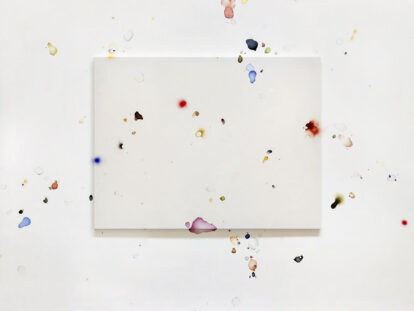
![Lendo com os pés [Reading with feet]](https://www.vervegaleria.com/wp-content/uploads/2023/03/Lendo-com-os-pes-768x777.jpg)
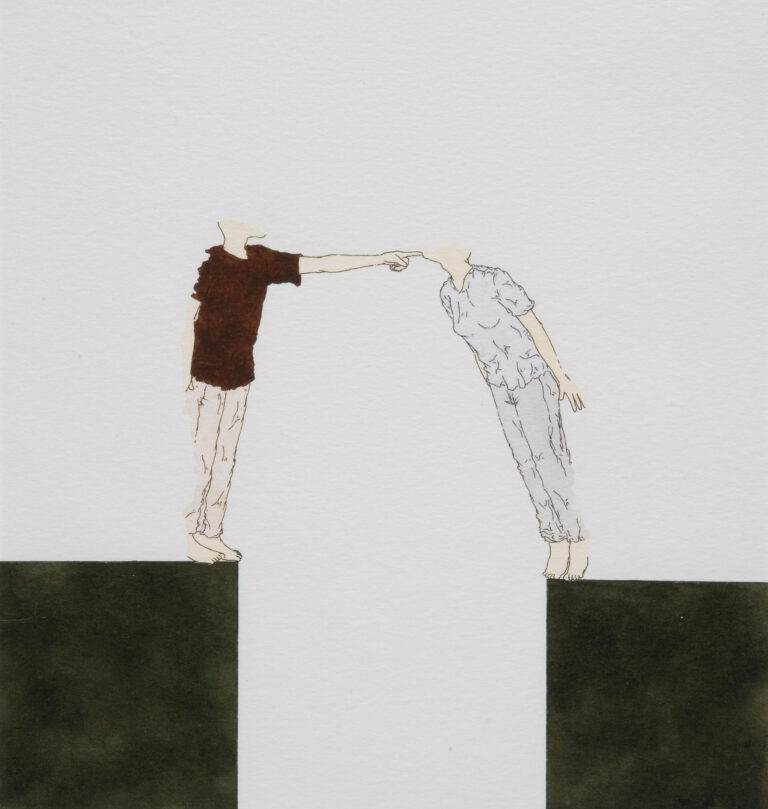
![No banco [In the bench]](https://www.vervegaleria.com/wp-content/uploads/2023/03/No-banco-2007-768x999.jpg)
![O Hábito [The Habit]](https://www.vervegaleria.com/wp-content/uploads/2023/03/O-Habito-768x1071.jpg)
![Retrato com mãos pintadas XI [Portrait with Painted Hands XI]](https://www.vervegaleria.com/wp-content/uploads/2023/03/Retrato-com-maos-pintadas-11-768x575.jpg)
![Registro de cores I [Color registration I]](https://www.vervegaleria.com/wp-content/uploads/2023/03/Registro-de-cores-768x512.jpg)
![Autorretrato como Godets [Self portrait as Godets]](https://www.vervegaleria.com/wp-content/uploads/2023/03/Autorretrato-como-Godet-768x422.jpg)
![Autorretrato como papel toalha sujo de tinta II [Self-portrait as an ink-stained paper towel II]](https://www.vervegaleria.com/wp-content/uploads/2023/03/Autorretrato-como-papel-toalha-sujo-de-tinta-II-768x1016.jpg)
![Natureza Morta (A.C.F.) I [Still Life (A.C.F.) I]](https://www.vervegaleria.com/wp-content/uploads/2023/03/Natureza-Morta-A.C.F.I-768x1016.jpg)
![Natureza Morta (B) [Still Life (B)]](https://www.vervegaleria.com/wp-content/uploads/2023/03/Natureza-Morta-B-768x808.jpg)
![Natureza Morta (NM) [Still Life (NM)]](https://www.vervegaleria.com/wp-content/uploads/2023/03/Natureza-Morta-NM-768x580.jpg)
![Natureza Morta (PBD) [Still Life (PBD)]](https://www.vervegaleria.com/wp-content/uploads/2023/03/Natureza-Morta-PBD-768x948.jpg)
![Natureza Morta (RMPUL) [Still Life (RMPUL)]](https://www.vervegaleria.com/wp-content/uploads/2023/03/Natureza-Morta-RMPUL-768x915.jpg)
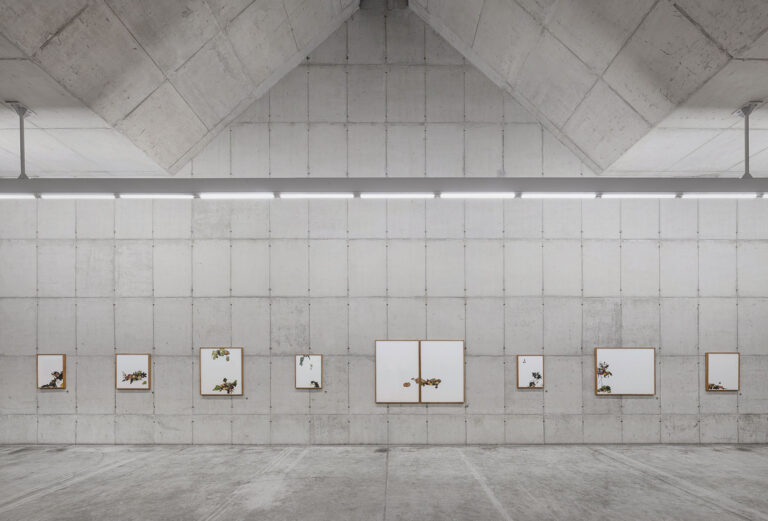
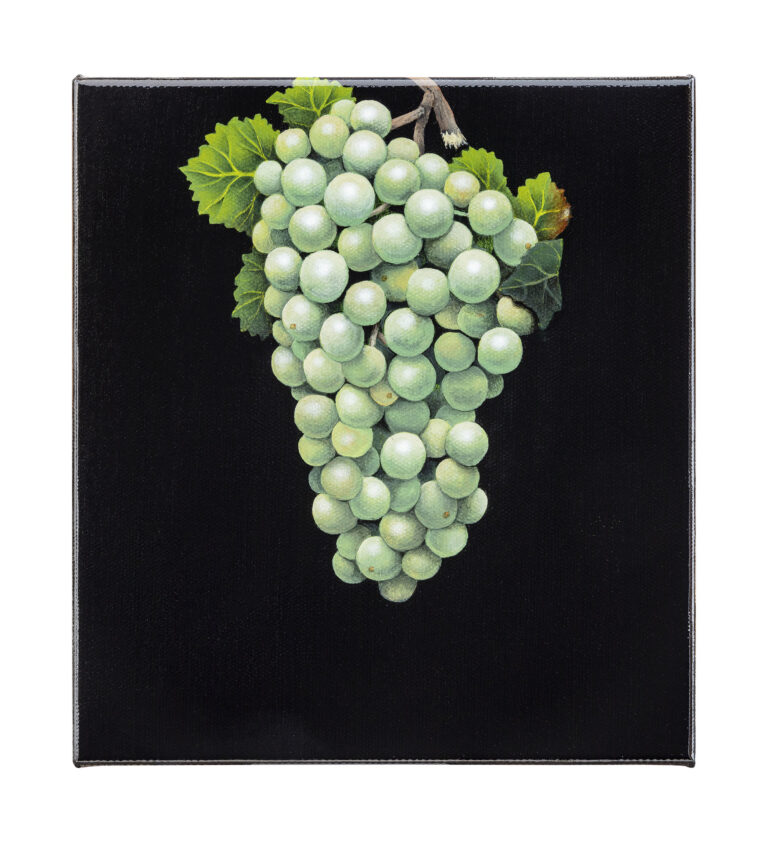
![Teoria da Jabuticaba I [Jabuticaba Theory I]](https://www.vervegaleria.com/wp-content/uploads/2023/03/Teoria-da-Jabuticaba-I-768x1248.jpg)
![Fitas [Tapes]](https://www.vervegaleria.com/wp-content/uploads/2023/03/Fitas-3-768x982.jpg)
![Autorretrato como teste de cores (o que sobrou) [Self portrait as a color test (what's left)]](https://www.vervegaleria.com/wp-content/uploads/2023/03/Autorretrato-como-teste-de-cores-o-que-sobrou-768x913.jpg)
![Autorretrato como teste de cores em tela [Self-portrait as a color test on canvas]](https://www.vervegaleria.com/wp-content/uploads/2023/03/Autorretrato-como-teste-de-cores-em-tela-I-768x768.jpg)
![Autorretrato como teste de cores [Self portrait as color test]](https://www.vervegaleria.com/wp-content/uploads/2023/03/Autorretrato-como-teste-de-cores-768x1016.jpg)
